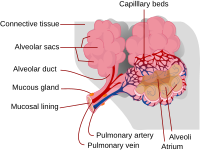
Photo from wikipedia
Pulmonary alveolar microlithiasis (PAM) is a fascinating rare lung disease that is associated with the accumulation of hydroxyapatite microliths within the lumen of the alveolar spaces. In most patients, PAM… Click to show full abstract
Pulmonary alveolar microlithiasis (PAM) is a fascinating rare lung disease that is associated with the accumulation of hydroxyapatite microliths within the lumen of the alveolar spaces. In most patients, PAM is discovered incidentally on radiographs performed for other purposes, and the typical disease course is characterised by slowly progressive respiratory insufficiency over decades. Recent genetic analyses that have revealed that the deficiency of the sodium-phosphate cotransporter NPT2B is the cause of PAM have enabled the development of powerful animal models that inform our approach to disease management and treatment. Here we review the epidemiology and molecular pathophysiology of PAM, as well as the diagnostic approach, clinical manifestations, radiographic and pathologic features, and clinical management of the disease. Although there are no proven treatments for PAM, progress in our understanding of disease pathogenesis is providing insights that suggest strategies for trials. A review of the epidemiology and molecular pathophysiology of pulmonary alveolar microlithiasis https://bit.ly/3lBgM7p
Journal Title: European Respiratory Review
Year Published: 2020
Link to full text (if available)
Share on Social Media: Sign Up to like & get
recommendations!